Volunteer vacations devoted to animals
Loading...
Kaitlyn Stone was searching for a way to help animals when she spotted an online ad for World Vets.
The organization, which provides free veterinary services around the globe, needed volunteers to assist with a week-long spay-neuter project in Loreto, Mexico, a small fishing village on the Sea of Cortez.
Even though Ms. Stone, a junior at the University of New Hampshire in Durham, had never flown alone or visited a foreign country, the idea instantly appealed to her.
"I felt this was the perfect way to try something new while doing the thing I love – helping animals," she says.
Stone isn't the only animal lover fueled by a desire to make a difference. Instead of sunning poolside, animal enthusiasts are using their vacation time to help needy pets in the United States and abroad.
World Vets, for instance, regularly sends volunteers and professionals to places that have limited or no access to veterinary care.
"We have an entire mobile hospital that we can pack up into four duffle bags and take with us and set up anyplace," says the organization's director, Cathy King.
Destinations are picked based on requests the group receives from animal-welfare groups in those areas. Most projects involve sterilization clinics coupled with basic wellness care and surgical training for local veterinarians.
The group's free services are in high demand, so much so that Dr. King recently sold her animal hospital in Wisconsin to take on World Vets as a full-time endeavor.
She says the week-long trips to foreign countries fill up quickly with about half a dozen assistants. Volunteers train for duties – such as giving shots – on location.
"A lot of people's expectation is that they aren't going to have an important job, or [be] given a token volunteer job," says King. "But what they love is they really do have something important to do."
Those taking part in volunteer vacations can expect to work more than they play. They may toil long hours with usually only a day or two allotted for sightseeing. But for many, that's exactly why they signed up for this kind of trip.
Still, says Emma Clifford, founder of Animal Balance, which organizes high-volume sterilization campaigns in the Dominican Republic and the Galápagos Islands, it can be a bit of a shock in the beginning. For one thing, volunteers are being asked to work hard in a job they may have never done before. And a typical work day can start at 7:30 a.m. and not end until 6 p.m. or later.
"It can be a little bit scary for some people," says Ms. Clifford, "but normally by Day Three or Four they love it."
Each Animal Balance project has about seven nonveterinary volunteers who keep a watchful eye on recovering animals, clip nails, clean ears, as well as deal directly with pet owners.
Working in a foreign country has its challenges, says Clifford. When her organization first offered its free spaying and neutering services on the Galápagos Islands, for example, no one came to the clinic for three days. Locals feared that the foreigners were going to harm their animals. (While spay-neuter surgery is a common procedure in the US, elsewhere it can sometimes be a new concept.)
So Clifford did an impromptu doggy wash in the town square, using a few strays off the street. "The dogs were very confused as to what's going on because they'd never had a bubble bath in their lives," she recalls with a laugh.
It didn't take long for a crowd of curious onlookers to gather. As people watched volunteers happily grooming the bewildered mutts, their mistrust faded.
Today, five years later, Animal Balance has sterilized 96 percent of the islands' cats and dogs. Also, three animal clinics have been established, four Ecuadorian veterinarians have been trained in spay-neuter surgery, and local authorities encourage people to sterilize their pets. (Previously, officials poisoned animals to control the overpopulation problem.)
Even though volunteers donate their time, the trip isn't free. People must pay their own airfare, although Clifford says she does her best to find free or inexpensive accommodations for her unpaid helpers.
"I fully understand that they've put so much energy and made so many sacrifices coming on these projects that I'll do everything I possibly can to make sure they'll have an amazing time," she says.
For American animal enthusiasts who would rather not travel abroad, Utah's Best Friends Animal Society sanctuary is closer to home. As the largest no-kill animal refuge in the country, the sanctuary cares for about 2,000 abused and abandoned animals, ranging from dogs and cats to horses and birds.
Located in the heart of the "golden circle" of national parks, the refuge is within driving distance of the Grand Canyon, Zion, Bryce Canyon, and Lake Powell.
Last year more than 6,500 people traveled to the refuge to help in its work, says Kalene Craddock, Best Friends' volunteer manager, who notes that much of the interest in volunteering there stems from National Geographic's television series "DogTown," which is filmed at the sanctuary.
Volunteers can help for a few hours or a few days, and no prior experience is required. "As long as you love animals, you're good to go," Ms. Craddock says.
Most people stay in the nearby town of Kanab, but cottages, cabins, and RV spots are available on sanctuary grounds for a reasonable nightly fee.
Offering volunteer vacations wasn't a formal idea when the sanctuary opened two decades ago. Over time, though, enough people began showing up that a full-time staff member was needed to handle all the interest.
Today, during peak times – March and April, and June through mid-September – about 100 volunteers per day help staff with grooming, feeding, and exercising the animals.
"There's always something within us that wants to give back," Craddock says of the outpouring of support. "And I think this is how people give back."






